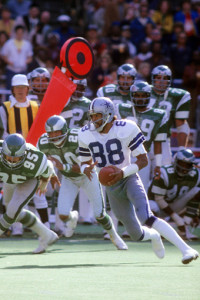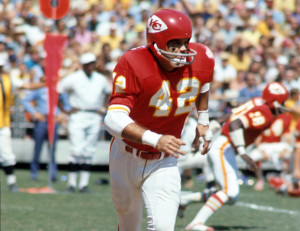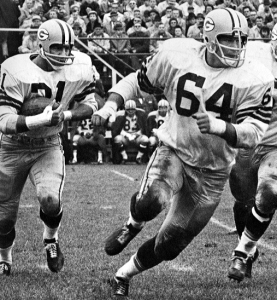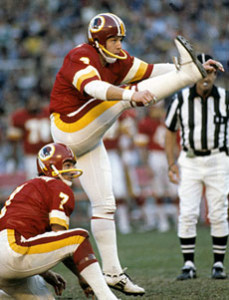Pro Football Hall of Fame Still Missing Many Deserving Players
With the Pro Football Hall of Fame inducting its newest class of enshrines, it provides the annual opportunity for discussion about which former NFL stars that seem worthy of being included in the Hall of Fame still are without busts in Canton.
Since he first became eligible in the early 1970s, former Green Bay Packers offensive lineman Jerry Kramer has been high on most lists of best players not in the HOF. As other Packers, as well as other offensive linemen with lesser career resumes, have received their HOF moment, Kramer has annually been denied.
A ten time HOF finalist, it has been nearly 20 years since Kramer last received serious HOF consideration. Some speculate that Kramer’s exclusion has been due to a glut of Packers from the 1960s. However, given that linebacker Dave Robinson became the 11th member of the 1960s Packers inducted just three years ago, that doesn’t seem totally accurate.
Given that the HOF selection committee has a history of vendettas (Ken Stabler was not selected until a year after his death), the explanation that seems more plausible has to do with Kramer’s foray into the world of journalism.
Following the 1967 season, Kramer and journalist Dick Schapp chronicled what turned out to be the last of the five championship teams of the 1960s in the award winning book Instant Replay. Two decades later, Kramer and Schapp revisited those players in the book Distant Replay.
There has been some speculation that journalists at the time resented Kramer treading into their world. In addition, because the Packers were known for their team mentality, having one player step out as a self-proclaimed spokesperson may have also created resentment.
Kramer’s on-the-field accolades would seem to unquestionably be HOF worthy. A five-time first team All-Pro offensive guard, Kramer was one of the lead blockers of the famed Packer Sweep. He also threw the lead block on one of the most famous plays of all-time to help the Packers defeat Dallas in the 1967 NFL Championship Game. In 1969 he was honored as one of the members of the NFL All-Time team for the 50th Anniversary of the league.
In recent years, his contemporaries Gene Hickerson, Billy Shaw and Dick Stanfel have received HOF selection while Kramer continues to wait for the call. Given that Stanfel is being inducted this year, slightly more than a year after his death at the age of 87, I hope the HOF Committee doesn’t wait too much longer before electing the 80-year-old Kramer.
While he is the most notable, Kramer is one of many former NFL stars who seem to have a strong case for HOF selection, especially when compared to others from their own era who have been inducted. Below is a breakdown of how some of those players compare with others from their own era who are members of the HOF.
1970s Wide Receivers:
Inducted: Lynn Swann (9 yrs, 336 receptions, 5,462 yards, 51 TD, 1 time All-Pro; Career-Highs: 61 receptions, 880 yards, 11 TDs)
Not Inducted: Drew Pearson: (11 yrs, 489 rec., 7,822 yds., 48 TD, 3 time All-Pro; Career-highs: 62 rec., 1,087 yds, 8 TD)
Cliff Branch: (14 yrs, 501 rec., 8,685 yds., 67 TD, 3 time All-Pro; Career-Highs: 60 rec., 1,111 yds., 13 TD)
Harold Jackson: (16 yrs., 579 rec, 10,372 yds., 76 TD, 1 time All-Pro; Career-Highs: 65 rec., 1,116 yds., 13 TD)
Otis Taylor: (11 yrs., 410 rec., 7,306 yds., 57 TD, 2 time All-Pro; Career-Highs: 59 rec., 1,297 yds., 11 TD)
While I have included only these four, in reality there are perhaps a dozen or more receivers who like Swann played much of their careers before the new rules started to increase the numbers for receivers in the late 1970s and are more deserving of being in the HOF than the former Pittsburgh Steeler.

Drew Pearson is one of several deserving wide receivers who has not been inducted into the Pro Football Hall of Fame.
Of all of the former players who are in the Hall of Fame, it is very difficult to find anyone less HOF worthy than Swann. Yes, he had three of the best performances of his career in three of the Steelers Super Bowl wins, but being a Hall of Fame player is about more than just playing well in a championship game. If it were about how you played in Super Bowls, then Doug Williams, Timmy Smith, Matt Snell, Clarence Davis and Rod Martin (among others) would have a case for HOF status.
Of the four receivers I have highlighted, only Jackson was not part of at least one Super Bowl winner. In addition, Swann never had a 1,000 yard receiving season and all of the others led the NFL in receptions, receiving yards or yards per catch at least once. Swann’s average season numbers were 37 receptions and 607 yards. Even in the era before defensive backs were prohibited from touching receivers after five yards those numbers are not impressive and not as good as Pearson, Branch, Jackson, Taylor or any number of others.
Unlike Swann, the other four receivers all were unquestionably the primary receiving threat on their team for at least part of their career, which meant they received double and triple coverage in a way Swann rarely did due to the presence of fellow Hall of Famer John Stallworth as the other receiver.
Placekickers:
Inducted: Jan Stenerud (19 yrs., 66.8FG%, 96.5PAT%, 1,699 points, 1 time All-Pro; Career-Highs: 91.7FG%, 100PAT%, 129 points)
Not Inducted: Nick Lowery (18 yrs., 80FG%, 98.9PAT%, 1,711 points, 1 time All-Pro; Career-Highs: 91.9FG%, 100PAT%, 139 points)
Morten Andersen (25 yrs., 79.7FG%, 98.8PAT%, 2,544 points, 3 time All-Pro; Career-Highs: 89.3FG%, 100PAT%, 122 points)
Mark Moseley (16 yrs., 65.6%, 94.1PAT%, 1,382 points, 1 time All-Pro; Career-Highs: 95.2%, 100PAT%, 161 points)
Gary Anderson (23 yrs., 80.1FG%, 99.2PAT%, 2,434 points, 1 time All-Pro; 100FG%, 100PAT%, 164 points)
Much has been made of the fact that Jan Stenerud is the only pure placekicker who has ever been inducted into the Pro Football Hall of Fame. Other than Lowery and Moseley, it is hard to make a legitimate HOF case for any other kicker from that time period.
Lowery, who replaced Stenerud in Kansas City, passed Stenerud’s career numbers, and certainly has some HOF case. Moseley’s percentage is consistent with Stenerud and others from that era. His greatest justification for HOF consideration is being the only pure kicker ever named NFL MVP (in 1982). The following season, he scored what was then an NFL record for a pure kicker with 161 points.
Gary Anderson and Morten Andersen are a pair of kickers who came into the league in 1982 and obliterated many records during more than two decades in the league. There can certainly be a case made for both to join Stenerud in the HOF as they rank as the two leading scorers in NFL history.
Ironically, one of the arguments against both of them is an argument that didn’t seem to stick for Stenerud. The careers of both Anderson and Andersen included notable missed field goals during crucial moments.
Anderson was perfect during the 1998 regular season, but missed a field goal late in the NFC Championship Game that would have likely sealed a trip to the Super Bowl. Instead, he missed the kick and Atlanta rallied to reach the Super Bowl thanks to a game-winning field goal by Morten Andersen.
However, Andersen also had a notable career miss as he missed a potential game-winning kick in the final week of the 1996 regular season that helped the Jacksonville Jaguars make the playoffs in only their second season.
In the iconic 1971 AFC Playoff Game between the Chiefs and Miami Dolphins, Stenerud twice missed what would have been a game winning field goal.
1960-1970 Defensive Backs:
Inducted: Roger Wehrli (14 yrs., 40 INT, 309 yds., 2 TD, 3 time All-Pro)
Dick Lebeau (14 yrs., 62 INT, 762 yds., 3 TD, 0 time All-Pro)
Not Inducted: Cliff Harris (10 yrs., 29 INT, 281 yds., 1 TD, 3 time All-Pro)
Louis Wright (12 yrs., 26 INT, 360 yds., 1 TD, 2 time All-Pro)
Johnny Robinson (12 yrs., 57 INT, 741 yds., 1 TD, 5 time All-Pro)
Ken Riley (15 yrs., 65 INT, 596 yds., 5 TD, 1 time All-Pro)
Deron Cherry (11 yrs., 50 INT, 688 yds., 1 TD, 3 time All-Pro)
Donnie Shell (14 yrs., 51 INT, 490 yds., 2 TD, 3 time All-Pro)
Of all positions, defensive back is probably one of the most difficult to try and utilize statistics as justification for Hall of Fame status.

Johnny Robinson intercepted 57 passes and was a five-time first team All-Pro for the Kansas City Chiefs.
Of the defensive backs who played most of their careers in the 1960s and 1970s and are in the Hall of Fame, Wehrli and LeBeau are the two whose selection seems the most iffy, especially when comparing them to others from their era.
Supporters of LeBeau point to his 62 career interceptions as justification for his selection. However, he is one of only a handful of Hall of Fame members who was never a first team All-Pro at his appointed position. In addition, given that he played with three Hall of Famers during his career (Dick Night Train Lane, Yale Lary and Len Barney), you could certainly say that he likely had more chances to intercept passes than others.
Roger Wehrli was a three-time All-Pro for the Cardinals, but there are several others who were recognized as All-Pro a comparable number of times, but are not in the HOF. Cliff Harris, Donnie Shell and Johnny Robinson were first team All-Pro as often (or more) than Wehrli, but all have Super Bowl rings.
It is part of the hypocrisy of the Hall of Fame that there are some players who are in the HOF in part because they were part of championship teams, but there are others who seem to have been punished by being on a championship squad.
Longtime Sports Illustrated writer Paul Zimmerman once called Harris one of the best players of all-time, yet he has struggled to get HOF consideration. He was a finalist in 2004, but has not reached that stage since.
An offensive player for his first two seasons, Robinson moved to defensive back during his third year and was a first team All-Pro five times in 10 years. He was a Hall of Fame finalist six times during a seven year stretch starting in 1980, but has not been a finalist for the HOF since 1986.
In recent years the HOF selection committee has done a good job reducing the backlog of deserving players needing selection for the HOF, but they still have much work to do. Hopefully in the coming years some of the players highlighted here will finally earn their well-deserved place in Canton.

